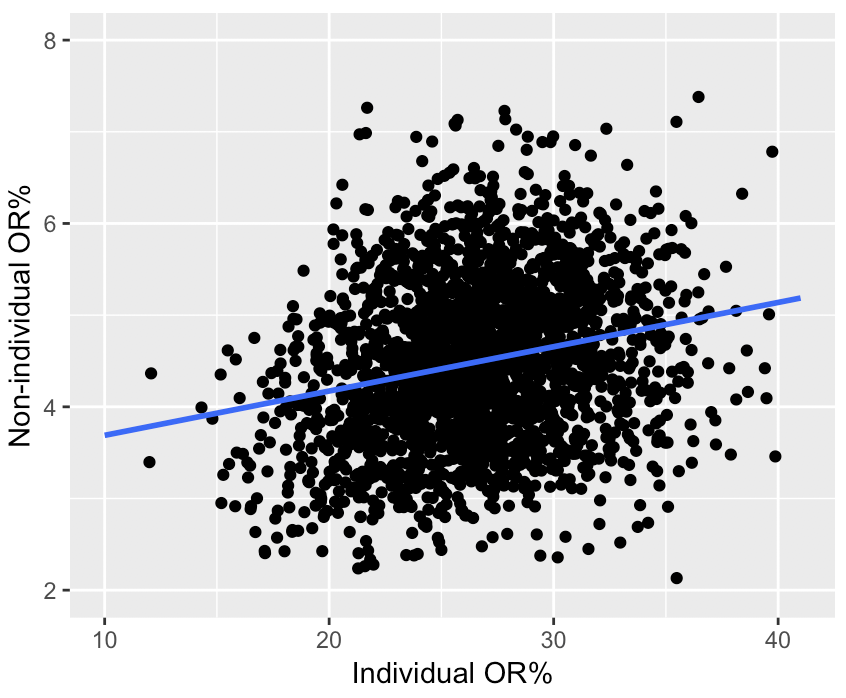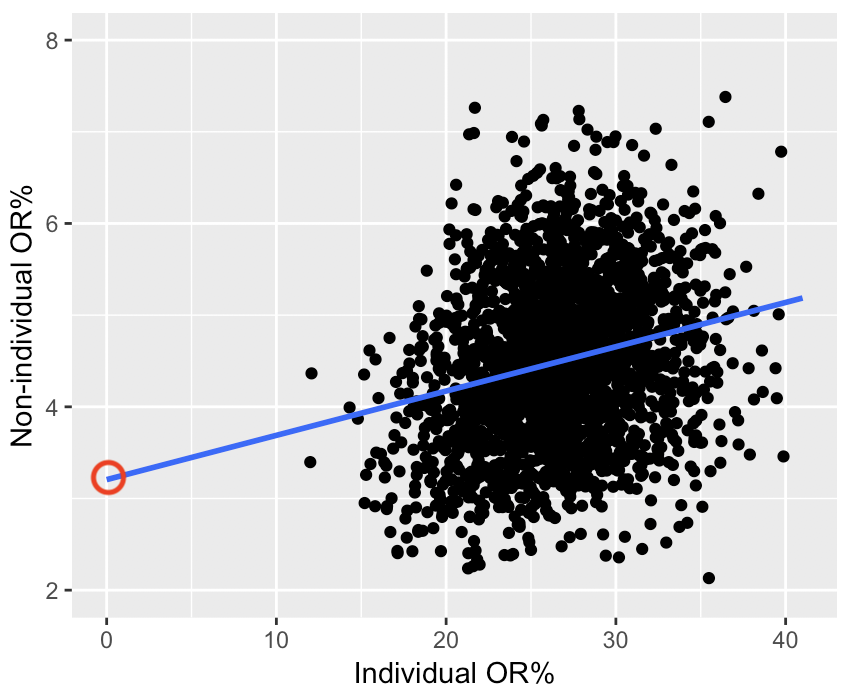Through ten games, Wyoming’s leader for offensive rebounds is Hunter Thompson who has six. So far this season, an individual has had at least that many offensive boards in a single game 251 times1. A total of 41 players have done it at least twice already. As a team, Wyoming players have been credited with just 29 offensive rebounds so far. That’s five fewer than Kofi Cockburn in two more games.
It’s not that Wyoming isn’t ever trying for offensive rebounds, but the Cowboys are coming as close to that practice as any team in modern history. With an offensive rebound percentage of 12.8, the record for lowest OR% in a season is in jeopardy.
Worst OR% since 1997
20 Wyoming 12.8 1. 17 Liberty 15.0 2. 03 Air Force 15.4 3. 19 Wyoming 15.9 4. 05 Army 15.9 5. 11 Denver 16.4
Wyoming doesn’t always surrender once a shot goes up. They occasionally win the scramble for a long rebound after a 3-pointer or a loose ball after a blocked shot. But they almost never get the kinds of offensive rebounds that Cockburn gets: winning a physical battle for a ball near the rim.
However, what if a team didn’t try at all? Say once a shot went up, all five players sprinted to the other end of the floor. How many offensive rebounds would they get?
You might think the answer is zero, but it’s not zero. In basketball as in life, sometimes you get rewards even when you don’t try. For instance, there will be times when your opponent blocks a shot directly out of bounds. Despite what your favorite elderly broadcaster will tell you, even Bill Russell did this from time to time.
When this happens you get an offensive rebound that is not credited to an individual. It is credited to the team. In addition to the 29 individual offensive rebounds credited to Wyoming, the Cowboys have benefited from an additional 12 “team”, or non-individual rebounds.
I’m not sick enough to go through Synergy and figure out how many of those non-individual rebounds were pure luck and how many were the result of effort. But it stands to reason that some non-individual rebounds are the result of effort. In every game, it seems like there’s at least one case of a defensive player fumbling a potential rebound out of bounds as he’s harassed by an opponent.2
We can test this using data. If effort produces more non-individual rebounds we should see that in a comparison of a team’s OR% based on individual rebounds to its OR% based on non-individual rebounds. Let’s take a look, using all teams from 2005-2019…

You favorite elderly broadcaster will tell you that you make your own breaks and in this case, there’s some truth to that. A team that is getting more individual offensive rebounds and theoretically contesting more offensive rebounds also gets a few more of those rebounds that the defense loses out of bounds and thus are not credited to an individual.
And herein lies a method to guess at what the offensive rebounding percentage might be for a team conceding every offensive rebound. Let’s just expand that horizontal axis a bit.

That’s the answer right there. At least, it’s my answer. Based on the relationship of non-individual OR% to individual OR% if a team stopped trying such that they got zero individual offensive rebounds, they’d still keep possession on about 3% of their missed shots due to non-individual rebounds.
Of course, this is completely theoretical. While Wyoming isn’t really trying to get offensive rebounds, there are cases where they are not exactly not trying either. It is not too unusual for the Cowboys to keep multiple players around the paint when a shot goes up. They are not trying to get an offensive rebound in any serious way, but they are there, existing. Just in case a loose ball should come their way, which it does two or three times a game.
But if a team ever actively tried to achieve absolute zero offensive rebounding, their opponents would catch on quick and not fumble the ball out of bounds one in every 35 times as the trend line would indicate. In fact, there are hints of that effect in the data already. The dots at the lower end of individual OR% tend to fall below the trend line more than one would expect if there was truly a linear relationship.
Against a team like North Carolina, the defense has to pursue every rebound with a certain aggressiveness, knowing that any delay will result in giving up an offensive board. Your favorite elderly broadcaster loves to say “be quick, but don’t hurry” but against North Carolina you have to hurry unless you want to give up a bunch of put-backs, and that leads to mistakes.
Against the likes of Wyoming, less urgency is needed. There is no need to hurry, or even to be quick for that matter. But there will still be offensive rebounds no matter how hard a team doesn’t try to get them.

